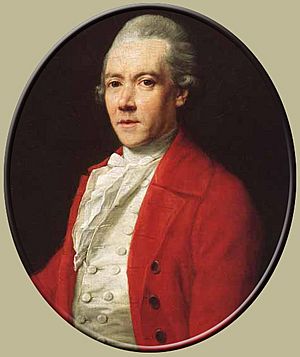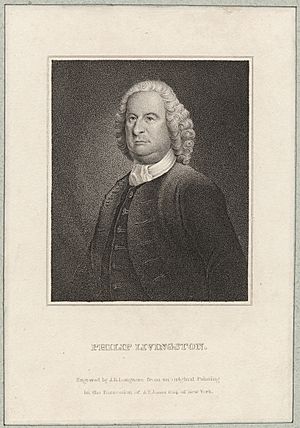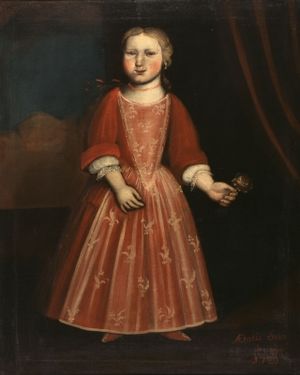Philip Livingston facts for kids
Quick facts for kids
Philip Livingston
|
|
|---|---|
 |
|
| Member of the New York State Senate |
|
| In office September 9, 1777 – June 12, 1778 |
|
| Preceded by | Created |
| Succeeded by | James Jay |
| Personal details | |
| Born | January 15, 1716 Albany, New York, British America |
| Died | June 12, 1778 (aged 62) York, Pennsylvania, U.S. |
| Nationality | American |
| Spouses |
Christina Ten Broeck
(m. 1740) |
| Children | 9 |
| Parents | Philip Livingston Catherine Van Brugh |
| Relatives | See Livingston family |
| Alma mater | Yale College |
| Occupation | Merchant, politician |
| Signature | |
Philip Livingston (born January 15, 1716 – died June 12, 1778) was an important American merchant and politician from New York City. He played a key role in the early days of the United States. He represented New York at the First Continental Congress in 1774. There, he suggested using economic pressure against Great Britain. This was to make the British Parliament remove unfair laws called the Intolerable Acts.
Livingston was also a delegate to the Second Continental Congress from 1775 to 1778. He famously signed the Declaration of Independence. This made him one of the Founding Fathers of the United States.
Contents
Early Life and Education
Philip Livingston was born in Albany, New York, on January 15, 1716. He was the fourth son of Philip Livingston, who was the second Lord of the Manor. His mother was Catherine Van Brugh Livingston. Philip grew up in the Albany area with his brother, William Livingston. They split their time between their father's home in Albany and the manor house in Linlithgo.
Philip graduated from Yale College in 1737. After college, he returned to Albany to learn the family business. He worked as an apprentice for his father, who was a merchant. His father's connections helped him get jobs in Albany's local government.
Building a Business Career
After his apprenticeship, Philip Livingston moved to New York City. He started his own business importing goods. He traded with the British sugar islands in the West Indies. During King George's War (1744–1748), Livingston became very wealthy. He made money by supplying goods for the war and through privateering. Privateering meant using private ships to attack enemy ships during wartime.
He also invested a lot in real estate and the slave trade. He owned a stone house in Manhattan and a large estate in Brooklyn Heights. Livingston became a successful merchant. He served as an alderman for the East Ward of New York City from 1754 to 1762. An alderman is a member of a city council.
Livingston also helped start important organizations. He supported the founding of Kings College, which is now Columbia University. In 1754, he helped create the New York Public Library. He founded the first Chamber of Commerce in New York in 1770. In 1756, he was a founding member and president of the Saint Andrew's Society of the State of New York. This was New York's first charity organization. He was also one of the first leaders of New York Hospital.
A Leader in Politics

In 1754, Philip Livingston became a delegate to the Albany Congress. At this meeting, he joined leaders from other colonies. They met to talk with Native American nations. They also discussed plans for the French and Indian War. Livingston actively worked to raise money and troops for the war effort. He owned shares in several privateer ships, showing his strong investment in the war.
He served in the provincial house of representatives from 1763 to 1769. In 1768, he became the speaker of the house. In October 1765, he attended the Stamp Act Congress. This meeting created the first official protest to the British Crown. It was an early step towards the American Revolution.
Livingston joined New York City's Committee of Correspondence. This group helped leaders in different colonies communicate. He also joined New York City's Committee of Sixty. When New York formed the New York Provincial Congress in 1775, he was chosen as its president.
Joining the Continental Congress
Philip Livingston was chosen as a delegate to the Continental Congress. His brother, William, also represented New Jersey at the Congress. In July 1775, Philip signed the Olive Branch Petition. This was a last effort to find peace with Great Britain. Like many early American Patriots, he first hoped to avoid a complete break from Britain. However, he eventually supported the fight against British rule.
When the British took over New York City, Philip and his family had to leave. They moved to Kingston, New York, where he had another home. After the Battle of Long Island, General George Washington and his officers met at Philip's home in Brooklyn Heights. They decided to evacuate the island. The British later used Philip's Duke Street home as a barracks for soldiers. They used his Brooklyn Heights home as a hospital for the Royal Navy.
After New York created its new state constitution, Livingston was appointed to the New York State Senate in 1777. He continued to serve in the Continental Congress at the same time. His health began to decline in 1778. He suffered from a condition called dropsy, which caused swelling.
Family Life
On April 14, 1740, Philip Livingston married Christina Ten Broeck (1718–1801). Christina was the daughter of Dirck Ten Broeck. She was also the sister of Albany Mayor Abraham Ten Broeck. Philip and Christina had nine children together:
- Philip Philip Livingston (1741–1787)
- Dirck "Richard" Livingston (born 1743), who never married.
- Catherine Livingston (1745–1810), who married Stephen van Rensselaer II.
- Margaret Livingston (1747–1830), who married Dr. Thomas Jones.
- Peter Van Brugh Livingston (born 1751), who never married.
- Sarah Livingston (1752–1814), who married her second cousin, Rev. John Henry Livingston.
- John Abraham Livingston (1754-1782), who worked for the Continental Army. He died unmarried.
- Alida Livingston (born 1757), who never married.
- Henry Philip Livingston (born 1760), a captain in General Washington's Life Guard. He died unmarried.
Death and Legacy
Philip Livingston died suddenly on June 12, 1778. He was attending a session of Congress in York, Pennsylvania. He is buried in Prospect Hill Cemetery there. Livingston was a Presbyterian and a Mason.
After his death, Livingston's estate had many debts. The New York Legislature passed a special law in 1785. This law appointed trustees to manage his property and pay his debts. His son, Philip Philip Livingston, was one of these trustees.
Through his son Philip, Philip Livingston was the grandfather of Edward Philip Livingston (1779–1843). Edward later became the Lieutenant Governor of New York. His granddaughter, Catherine, married Stephen Van Rensselaer III. Stephen was a very important landowner.
Several places are named after Philip Livingston. These include Livingston Avenue and the former Philip Livingston Magnet Academy in Albany, New York. A public school in Brooklyn, PS 261 in Boerum Hill, is also named for him.
See also
- Livingston family
- Memorial to the 56 Signers of the Declaration of Independence


